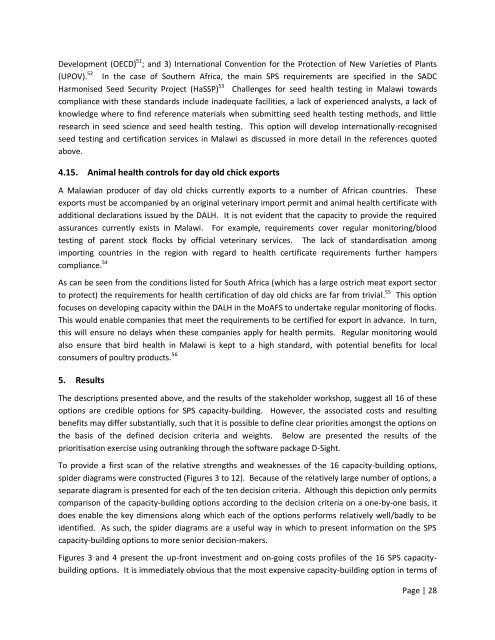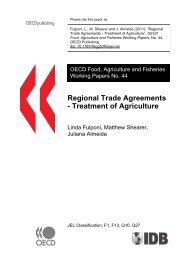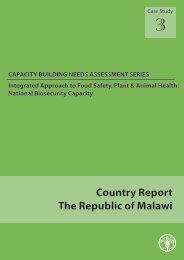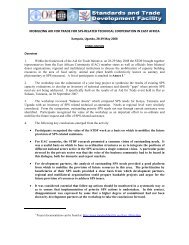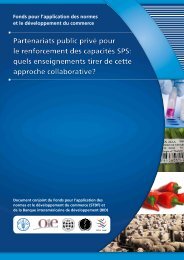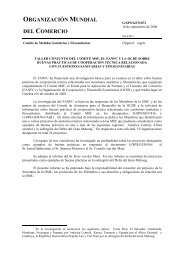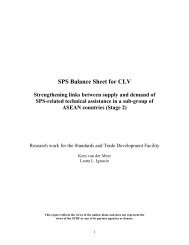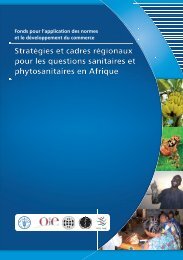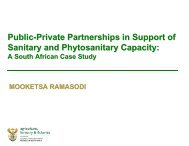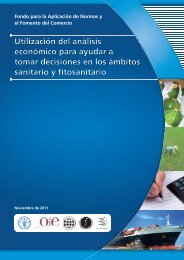MCDA Final Report Malawi - Standards and Trade Development ...
MCDA Final Report Malawi - Standards and Trade Development ...
MCDA Final Report Malawi - Standards and Trade Development ...
You also want an ePaper? Increase the reach of your titles
YUMPU automatically turns print PDFs into web optimized ePapers that Google loves.
<strong>Development</strong> (OECD) 51 ; <strong>and</strong> 3) International Convention for the Protection of New Varieties of Plants<br />
(UPOV). 52 In the case of Southern Africa, the main SPS requirements are specified in the SADC<br />
Harmonised Seed Security Project (HaSSP) 53 Challenges for seed health testing in <strong>Malawi</strong> towards<br />
compliance with these st<strong>and</strong>ards include inadequate facilities, a lack of experienced analysts, a lack of<br />
knowledge where to find reference materials when submitting seed health testing methods, <strong>and</strong> little<br />
research in seed science <strong>and</strong> seed health testing. This option will develop internationally-recognised<br />
seed testing <strong>and</strong> certification services in <strong>Malawi</strong> as discussed in more detail in the references quoted<br />
above.<br />
4.15. Animal health controls for day old chick exports<br />
A <strong>Malawi</strong>an producer of day old chicks currently exports to a number of African countries. These<br />
exports must be accompanied by an original veterinary import permit <strong>and</strong> animal health certificate with<br />
additional declarations issued by the DALH. It is not evident that the capacity to provide the required<br />
assurances currently exists in <strong>Malawi</strong>. For example, requirements cover regular monitoring/blood<br />
testing of parent stock flocks by official veterinary services. The lack of st<strong>and</strong>ardisation among<br />
importing countries in the region with regard to health certificate requirements further hampers<br />
compliance. 54<br />
As can be seen from the conditions listed for South Africa (which has a large ostrich meat export sector<br />
to protect) the requirements for health certification of day old chicks are far from trivial. 55 This option<br />
focuses on developing capacity within the DALH in the MoAFS to undertake regular monitoring of flocks.<br />
This would enable companies that meet the requirements to be certified for export in advance. In turn,<br />
this will ensure no delays when these companies apply for health permits. Regular monitoring would<br />
also ensure that bird health in <strong>Malawi</strong> is kept to a high st<strong>and</strong>ard, with potential benefits for local<br />
consumers of poultry products. 56<br />
5. Results<br />
The descriptions presented above, <strong>and</strong> the results of the stakeholder workshop, suggest all 16 of these<br />
options are credible options for SPS capacity-building. However, the associated costs <strong>and</strong> resulting<br />
benefits may differ substantially, such that it is possible to define clear priorities amongst the options on<br />
the basis of the defined decision criteria <strong>and</strong> weights. Below are presented the results of the<br />
prioritisation exercise using outranking through the software package D-Sight.<br />
To provide a first scan of the relative strengths <strong>and</strong> weaknesses of the 16 capacity-building options,<br />
spider diagrams were constructed (Figures 3 to 12). Because of the relatively large number of options, a<br />
separate diagram is presented for each of the ten decision criteria. Although this depiction only permits<br />
comparison of the capacity-building options according to the decision criteria on a one-by-one basis, it<br />
does enable the key dimensions along which each of the options performs relatively well/badly to be<br />
identified. As such, the spider diagrams are a useful way in which to present information on the SPS<br />
capacity-building options to more senior decision-makers.<br />
Figures 3 <strong>and</strong> 4 present the up-front investment <strong>and</strong> on-going costs profiles of the 16 SPS capacitybuilding<br />
options. It is immediately obvious that the most expensive capacity-building option in terms of<br />
Page | 28


